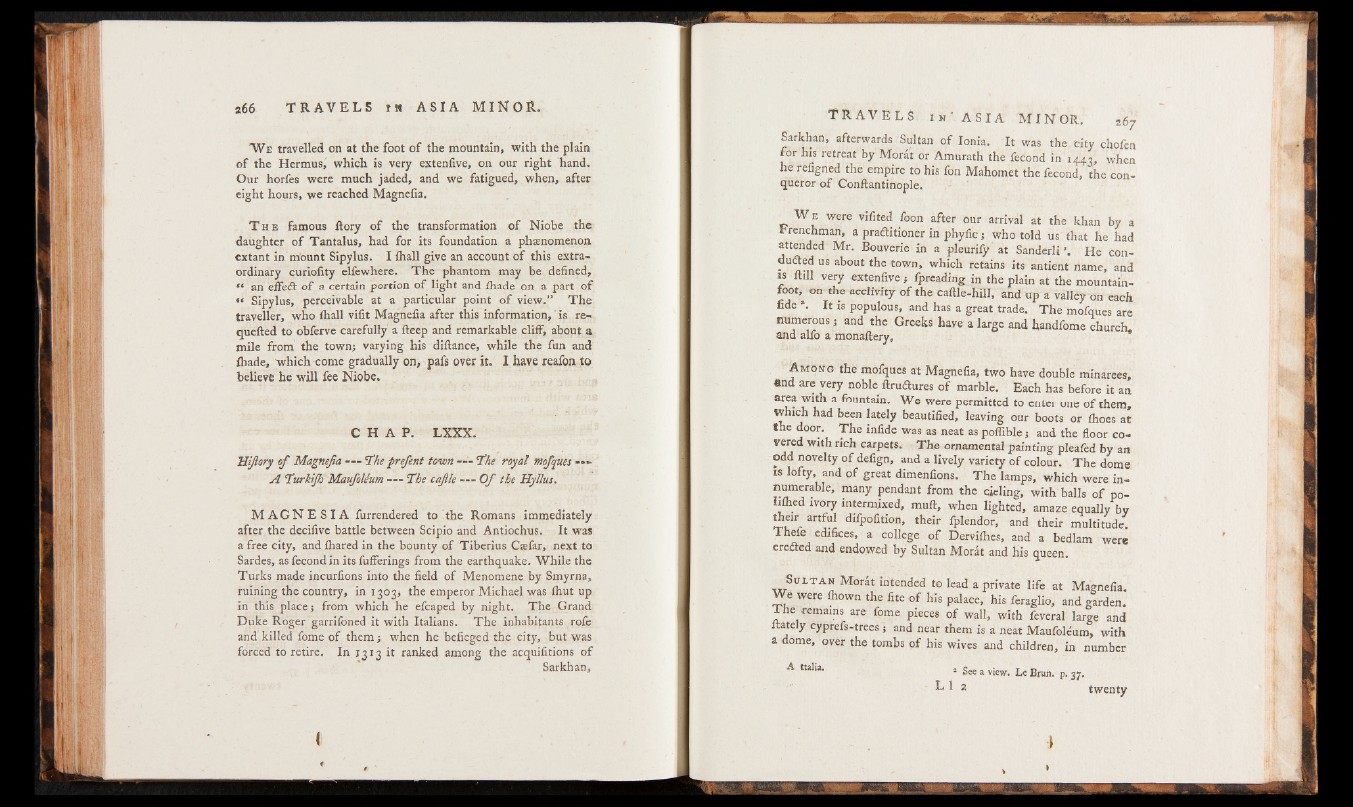
We travelled on at the foot of the mountain» with the plain
of the Hermus, which is very extenlive, on our right hand.
Our horfes were much jaded, and we fatigued, when, after
eight hours, we reached Magnefia.
T he famous ftory of the transformation of Niobe the
daughter of Tantalus, had for its foundation a phenomenon
extant in mount Sipylus. I {hall give an account of this extraordinary
curiofity elfewhere. The phantom may be defined,
“ an effeft o f a certain portion of ligh t and {hade on a part of
Sipylus, perceivable at a particular point o f view.” The
traveller, who {hall vifit Magnefia after this information, ’ is re-
quefted to obferve carefully a fteep and remarkable cliff, about a
mile from the town; varying his diftance, while the fun and
lhade, which come gradually on, pafs over it. I have reafon to
believe he will fee Niobe.
C H A P . LXXX.
Uifiory o f Magnefia — 'The prefent town — - The royal mofques —-
A Turkijh Maufoleum — The cafile — O f the Hyllus.
M A G N E S I A furrendered to the Romans immediately
after the decifivc battle between Scipio and Antiochus. It was
a free city, and fhared in the bounty of Tiberius Caefar, next to
Sardes, as fecond in its fufferings from the earthquake. While the
Turks made incurfions into the field of Menomene by Smyrna,
ruining the country, in 1303; the emperor Michael was {hut up
in this place; from which he efcaped by night. The Grand
Duke Roger garrifoned it with Italians. The inhabitants rofe
and killed fome of them; when he befieged the city, but was
forced to retire. In 1313 it ranked among the acquifitions of
Sarkhan,
I
* ' *
Sarkhan, afterwards Sultan of Ionia. It was the city chofen
ror his retreat by Moral or Amurath the fecond in 1443, when
he refigned the empire to his fon Mahomet the fecond, the conqueror
of Conflantinople.
W e were vifited foon after our arrival at the khan by a
Frenchman, a praftitioner in phyfic; who told us that he had
attended Mr. Bouverie in a pleurily at S a nde r l iHe con-
dudted us about the town, which retains its antient name, and
is ftill very extenfive; fpreading in the plain at the mountain-
foot, on the acclivity of the caftle-hill, and up a valley on each
fide*. It is populous, and has a great trade. The mofques are
numerous; and the Greeks have a large and handfome church,
and alfo a monaftery.
A m o n g the mofques at Magnefia, two have double minarees,
and are very noble ftruaures of marble. Each has before it an
area with a fountain. We were permitted to enter one of them.
Which had been lately beautified, leaving our boots or {hoes at
the door. The infide was as neat as poflible; and the floor co-
vered with rich carpets. The ornamental painting pleafed by an
odd novelty of defign, and a lively variety of colour. The dome
is lofty, and of great dimenfions. The lamps, which were innumerable,
many pendant from the cieling, with balls of po-
lifhed ivory intermixed, muft, when lighted, amaze equally by
their artful difpofition, their fplendor, and their multitude.
Thefe edifices, a college of Dervifhes, and a bedlam were
erefted and endowed by Sultan Morat and his queen.
S u l t a n Moral intended to lead a private life at Magnefia
We were foown the file of his palace, his feraglio, and garden.
I he remains are fome pieces of wall, with feveral large and
Jtately cyprefs-trees; and near them is a neat Maufoleum, with
a dome, over the tombs of his wives and children, in number
A ttalia. z gee # v;Wi Brun. p. 37.
L I 2 twenty